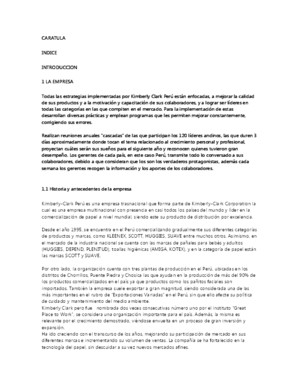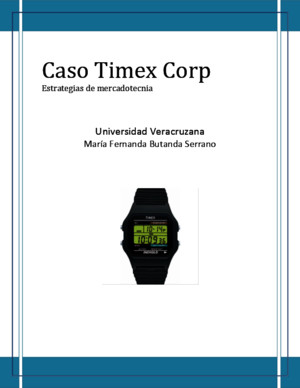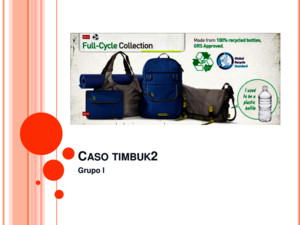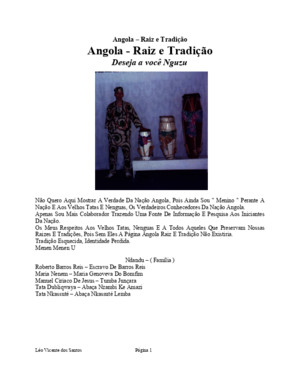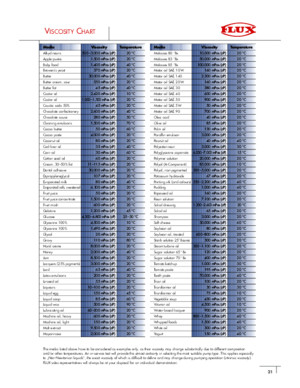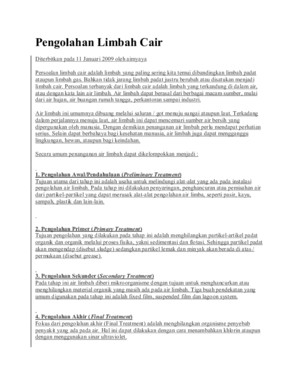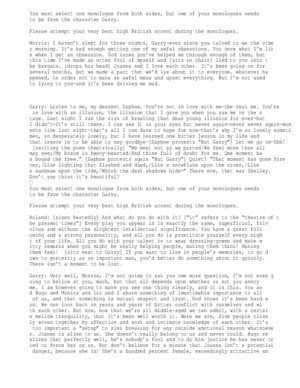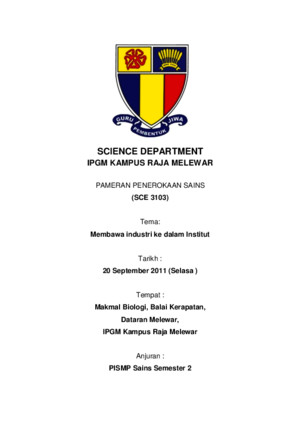Caso Kimberly Clark
There is document - Caso Kimberly Clark available here for reading and downloading. Use the download button below or simple online reader.
The file extension - PDF and ranks to the Documents category.
Tags
Related
Comments
Log in to leave a message!
Description
CASE: OB-72 DATE: 3/16/09 Megan Anderson prepared this case under the supervision of Professor Jeffrey Pfeffer as the basis for class discussion rather than to illustrate either effective or ineffective handling of an administrative situation Copyright © 2009 by the Board of Trustees of the Leland Stanford Junior University All rights reserved To order copies or request permission to reproduce materials, e-mail the Case Writing Office at: cwog
Transcripts
C ASE : OB-72 D ATE : 3/16/09 Megan Anderson prepared this case under the supervision of Professor Jeffrey Pfeffer as the basis for class discussion rather than to illustrate either effective or ineffective handling of an administrative situation Copyright © 2009 by the Board of Trustees of the Leland Stanford Junior University All rights reserved To order copies or request permission to reproduce materials, e-mail the Case Writing Office at: cwogsbstanfordedu or write: Case Writing Office, Stanford Graduate School of Business, 518 Memorial Way, Stanford University, Stanford, CA 94305-5015 No part of this publication may be reproduced, stored in a retrieval system, used in a spreadsheet, or transmitted in any form or by any means –– electronic, mechanical, photocopying, recording, or otherwise –– without the permission of the Stanford Graduate School of Business K IMBERLY -C LARK A NDEAN R EGION : C REATING A W INNING C ULTURE The culture is innocent It is really difficult when you are a grown-up to be a kid again — Sandra Benavides, Peru The new generations have different expectations, they have been exposed to new information and trends; they are more inclined to think in terms of people than the generation we grew up in — Sergio Nacach, Head of Kimberly-Clark, Andean Region Sergio not only has done a terrific job in his own region, he became the evangelist, if you will, the missionary for the remaining countries and sub-regions in Latin American Operations — Ramiro Garces, Vice President for Human Resources, LAO In the summer of 2008, Ramiro Garces, vice president of human resources for the Latin American region of Kimberly-Clark, the large consumer products company, was thinking about the many management changes spreading through the company almost like a virus Less than a decade earlier, Kimberly-Clark had hired an Argentinean, Sergio Nacach, from Unilever Nacach’s first job had been to run Kimberly-Clark’s operations in the small Central American country of El Salvador Now, Nacach was running the Andean region for K-C and producing impressive business results Because of his outstanding results, outgoing personality and willingness to talk to others about what he and his colleagues were doing, his management approach was generating interest throughout the company and particularly influencing its operations in Latin America Operations in this area already demonstrated an organizational culture and leadership approach that was largely consistent with Nacach’s management style, so he did not have to struggle to implement his ideas To make this different way of managing sustainable, the company needed to understand the essential elements of the Andean success There was also the issue, articulated by another Kimberly-Clark executive not working in the Andean region, concerning the extent to which this success was largely a function of the leader’s personality and leadership style, or whether the basic philosophy and management approach could be transferred to other parts of the company ― or even to another company in the absence of such a leader Do Not opy or Post This document is authorized for educator review use only by Carla Bernaola, Universidad Peruana de Ciencias Aplicadas (UPC) until June 2016 Copying or posting is an infringement of copyright Permissionshbspharvardedu or 6177837860 Kimberly-Clark Andean Region: Creating a Winning Culture OB- 72 p 2 Nacach also faced some challenges of his own First of all, even within the Andean region, there was the question of what his team could do to keep the momentum and energy going—to surmount the so-called “Hawthorne effect,” the idea that almost any positive change would work for a while until its effects diminished as the novelty wore off Second, Nacach was thinking about whether this specific management style, which was very warm and emotional—Latin in its essence—really would work in other places and parts of the world characterized by more interpersonal reserve And third, there was the question of what lessons could be drawn from the experience to help others build a winning culture K IMBERLY -C LARK IN L ATIN A MERICA AND THE A NDEAN R EGION In 2008, Juan Ernesto de Bedout, the group president for Kimberly-Clark’s Latin American Operations (LAO) to whom Nacach reported, oversaw Central and South America and the Caribbean (except K-C Mexico, which was a separate, publicly traded company) This large presence in Latin America represented a huge change from where the company had been just a couple of decades earlier, a transformation accomplished through the efforts of de Bedout and his colleagues When de Bedout, who holds bachelor’s and master’s degrees in industrial engineering from Purdue, had joined Kimberly-Clark in the early 1980s, the company was a tiny player in Latin America Market shares for K-C’s products in many countries were in the lower single digits Juan Ernesto de Bedout began his career for Kimberly-Clark working under Claudio Gonzalez, who was based in Mexico Although K-C de Mexico was a thriving operation, in South and Central America, Kimberly-Clark’s principal competitors, such as Johnson Johnson and Procter Gamble, had been operating for many years and had by far the leading market share There were also a lot of entrepreneurial companies making similar products, often for one or just a few markets Kimberly-Clark had ambitions to build a much bigger organization with far greater business success, which it did over time by completing more than 30 merger and acquisition deals with different entities as well as growing organically As de Bedout explained, “Some were buyouts, some were partnerships, some were 50/50 equity arrangements ― a whole array of combinations,” because Kimberly-Clark was competing for these deals with other key players Initially, K-C offered the purchased firms and their leaders a great deal of autonomy, but then the corporation felt the necessity to bring the different pieces under more control so that marketing and manufacturing could be aligned and the company could benefit from various economies of scale in both production and distribution “We re-engineered and reduced our footprint from roughly 50 to 25 plants, introduced an SAP financial management and control system, and initially transitioned to a matrix organizational structure organized by geography and product lines” By 2008, the regional organizational model had evolved substantially and Kimberly-Clark had become a leading player in most Latin American markets, building its competitive advantage by being close to the market and not operating as centrally as some of the competition—an approach referred to by many senior executives as “freedom within a framework” K-C was present in all countries on the South American continent as well as throughout Central America Do Not opy or Post This document is authorized for educator review use only by Carla Bernaola, Universidad Peruana de Ciencias Aplicadas (UPC) until June 2016 Copying or posting is an infringement of copyright Permissionshbspharvardedu or 6177837860 Kimberly-Clark Andean Region: Creating a Winning Culture OB- 72 p 3 and many Caribbean countries, and in many instances had market shares for its products exceeding 50 percent ― quite an accomplishment considering the entrenched competition and the speed of its establishment in the area In parallel, the company culture and employee engagement were rated very high even though the Latin American operations had gone through a lot of restructuring and consolidation Ramiro Garces noted: Over the past years, we have built very high engagement throughout the Andean region As a matter of fact, according to the Great Place to Work Institute, K-C Peru and K-C Ecuador were rated number one and K-C Colombia number four (2007 results) in their own countries compared to all the other companies (local and multinational) in those countries This is no accident, as results this good have been consistent over the last years The Andean Region In 2009, Kimberly-Clark´s Andean region consisted of the five countries of Peru, Ecuador, Bolivia, Venezuela, and Colombia These five countries faced the same oil and raw material price increases as everyone else, while additionally confronting their own political and economic issues Venezuela’s economy and infrastructure faced problems, resulting from Hugo Chavez’ struggles to gain power by using the country’s oil wealth to exert political influence and quarrel with the United States In Bolivia, calls for more regional autonomy within the country had been accompanied by massive demonstrations, occasional street violence, and economic conflict Cross-border disputes and military confrontations had broken out between Colombia and its neighbors, as a leftist guerrilla movement caused tensions Despite some natural resources, this was not a wealthy area and certainly it had neither the size nor the apparent economic vitality of, for instance, Brazil Nonetheless, for Kimberly-Clark the Andean region was economically successful In 2007, the Andean region accounted for a significant share of the growth in net operating income for the entire Kimberly-Clark Corporation ( Exhibit 1 shows recent financial results for the Andean region and the five countries within it) The Andean region’s headquarters in Lima, Peru, were in an office building in a suburb The operation in Peru had been purchased as part of the wave of acquisitions, and initially the people running the srcinal company had stayed in charge Although the Peruvian company was very profitable, by 2004 growth was slowing because of its already large market share Mario Escudero, a senior manager who had been with the company since he began his career, described the culture at that time: It was a culture where costs were always controlled… The solution was always to come from better products and better advertising The sales function was considered sort of a necessary mechanism, but by no means the most glamorous… Decisions were top-down and the senior positions had all of the power When Nacach arrived to run Peru and Bolivia in 2004, two previous attempts to put together an integrated Andean region had encountered problems Despite an overall similarity in outward expression, there was great diversity in management style and approach among the country Do Not opy or Post This document is authorized for educator review use only by Carla Bernaola, Universidad Peruana de Ciencias Aplicadas (UPC) until June 2016 Copying or posting is an infringement of copyright Permissionshbspharvardedu or 6177837860
Recommended

